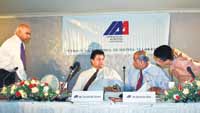Levies and level playing fields on Lankan TV It came to be a law quickly and was implemented even quicker, but what does the Finance (Tele-drama, Film, and Commercial Levy) Regulations, No 1 of 2006 come down too? Since it came into effect there hasn’t been a day going by without those affected decrying it for what it stands for and the financial consequences, while those defending have been proclaiming the benefits to be seen in the future. So where do we all stand and what exactly
is going on?
One of the main detractions of the Gazette’s explanation is the lack of clarity when talking about foreign commercials. Ranil de Silva, Managing Director of Leo Burnett Solutions and International Advertising Association (AAI) Sri Lanka Chapter President, said, “There is a Rs 1 million tax put on a foreign commercial for a year, but the business doesn’t work like that. There are commercials decided that will last for three months, six, and some for a year, but even those come in bursts, and the Rs 1 million covers all it seems.” On the matter of the companies that advertise the last thing they say they need is such added expense. As Gerald de Saram, Managing Director of CIC Paints, said the Sri Lankan market is small and price sensitive and is very dependant on attracting investment from global players, where the market for multinationals is a “nice to have” rather than a “need to have”. Now there are those who could say why do we need the multinationals? But if you think about it there will be limited brand awareness, meaning restricted choice due to restricted competition. “There will also be a lack of sponsorships to support the kind of programming that the Sri Lankan population has got used too,” De Saram said, adding that it will also lead to lower quality programming due to a lack of money going to the TV station to be able to afford the programming they want. But what of the local production industry
and where does it stand? S. Dharmaratne, Cinelink’s Director, hopes to benefit but is not too sure where the money raised from the tax is actually going to go. “At the moment we are struggling. Presently if a TV station was to order a tele-drama, we can get a loan to make it. The problem is it doesn’t happen that often as the airtime is filled with imports.” He also worries about the limited talent available in the country from the number of actors available to the quality of shows produced. “We can’t compete with India for quality of cameras, wardrobe, make-up and the rest. For documentaries and research we are fine, but for drama it is a different story.” A comment echoed by the advertising industry was the quality of equipment available with Thayalan Bartlett, CEO of JWT, saying there were only three high-grade TV cameras in the country, and adding: “without talking about the need for foreign visits for, say, animation.” And with the advertising industry, so soon after the Chillies awards, it is about upgrading the quality so they can compete in the world market which would bring in much needed revenue. Maclear Films’Geethika Palipane, tele-drama director and script writer, said the move would help the local industry as there were 4,000 people in the business ready to be employed more regularly. “Around 10 to 15 years ago we made good programmes and that was lost over the years with the availability of cheap imports. We have home-produced directors and technicians working abroad. We have the talent, we just need the chance,” she said. “It costs us around Rs 125,000 to produce one episode in a drama, but compared to stations buying Indian ones for as little as Rs 30,000 to Rs 40,000, we can’t compete,” Palipane said. According to Ashoka Serasinghe, Chairman, National Film Corporation, who has been quoted many times this last week, those 340 (tele-dramas) have been approved but have no air time due to cheaper imports. And he is adamant that locally produced programmes are superior, citing appearances in regional and other movie and TV festivals. “Even though the fund hasn’t been set up at the moment for the distribution of the money collected, when it is, hopefully it will go to improving the whole industry as a whole, from standards in production to standards of cinemas the people go to,” the chairman said. So where does it leave the consumer; the person who buys the products and decides which channel to watch? As usual time will tell, and as has been said in the press conferences taking place all last week and beyond, compromise seems to be the necessity. But it does seem to be a very abrupt, expensive, legislation without any serious talking to those affected, and when is that fund going to be set up? And will that money really go to the right people? One can only hope. There is talent on this island and it does deserve to be encouraged, but shouldn’t it be fair for all? (RI)
|
||||
Copyright © 2006 Wijeya Newspapers
Ltd. All rights reserved. |

 The
International Advertising Association (IAA) Sri Lanka Chapter
last week aired their concerns over the recently introduced
levy on foreign TV commercial and movies.
The
International Advertising Association (IAA) Sri Lanka Chapter
last week aired their concerns over the recently introduced
levy on foreign TV commercial and movies.